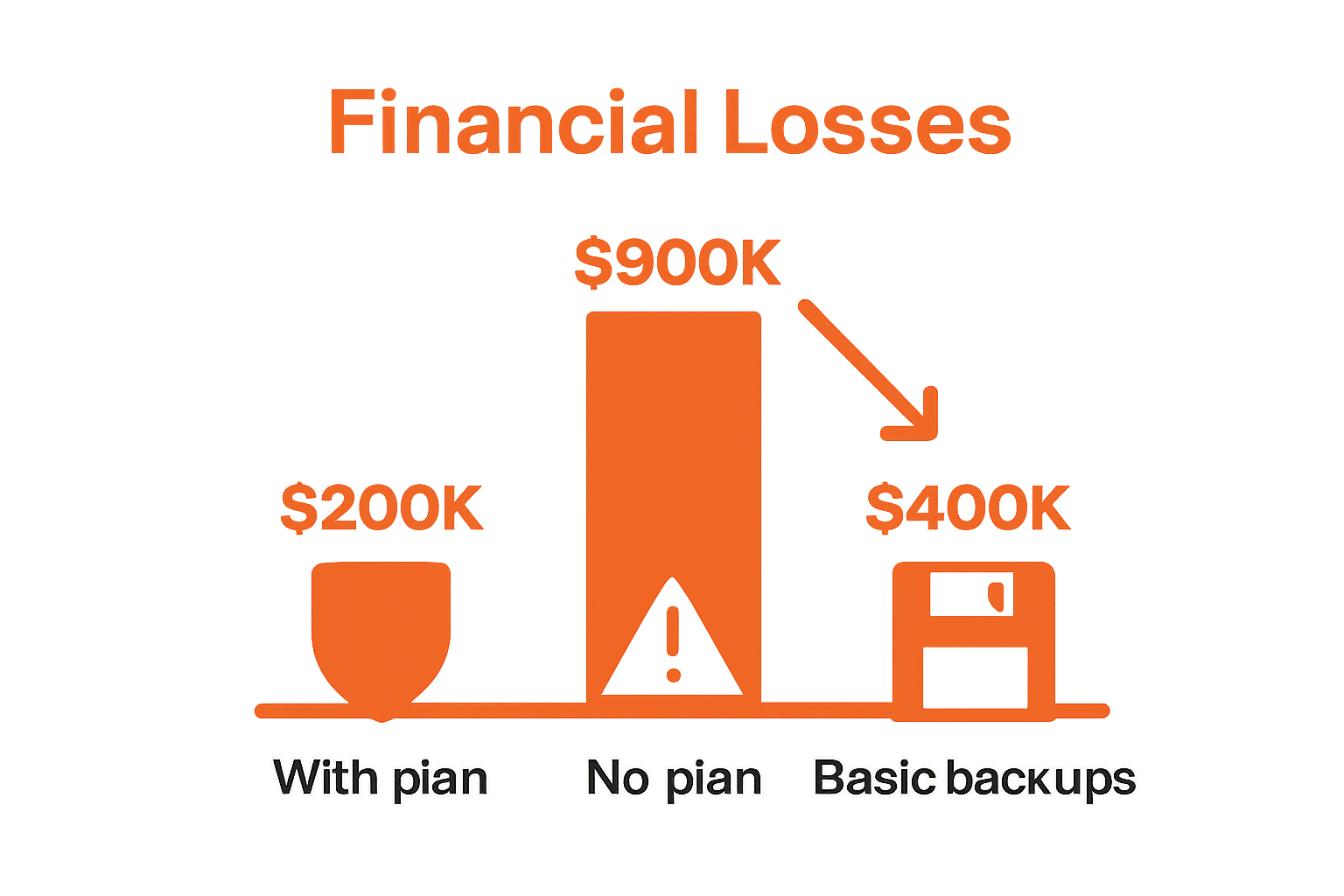
Understanding Disaster Recovery Planning for Businesses
Disaster recovery planning sounds like something most businesses put off until it is too late. You would think maybe it does not matter unless a tsunami or hacking group comes knocking. But more than 93 percent of companies without a disaster recovery plan shut down within a year after major data loss. That is the real wakeup call most people miss.
Table of Contents
- What Is Disaster Recovery Planning And Its Importance?
- The Key Principles Behind Effective Disaster Recovery
- How Disaster Recovery Planning Protects Your Assets
- Common Challenges In Disaster Recovery Planning
- Real-World Examples Of Disaster Recovery In Action
Quick Summary
| Takeaway | Explanation |
|---|---|
| Disaster recovery planning is essential for businesses | A strategic approach safeguards infrastructure and ensures continuity during disruptions. Without it, companies risk severe losses and operational failure. |
| Conduct thorough risk assessments regularly | Understanding vulnerabilities in technology is crucial. It helps identify critical systems and potential failure points, enabling proactive recovery measures. |
| Implement robust backup and restoration protocols | Dynamic protocols are needed to maintain operations. This includes clear recovery objectives and communication strategies to quickly address any disruptions. |
| Continuous testing and updating of plans are vital | Regularly refining recovery strategies ensures they remain effective against evolving technological threats and risks, maintaining business resilience. |
| Invest in technology for protection and resilience | Strategic investments in technology enhance recovery capabilities, allowing organizations to respond rapidly to disruptions and protect valuable assets. |
What is Disaster Recovery Planning and Its Importance?
Disaster recovery planning represents a critical strategic approach businesses use to protect their technological infrastructure and operational continuity during unexpected disruptions. At its core, disaster recovery planning involves creating comprehensive strategies that outline precise protocols for responding to potential technological failures, cybersecurity incidents, natural disasters, or other significant operational interruptions.
Understanding the Fundamental Concept
Disaster recovery planning goes beyond simple reactive measures. It is a proactive methodology designed to minimize potential damage, reduce downtime, and ensure rapid restoration of critical business functions. The fundamental goal is developing a systematic framework that allows organizations to respond quickly and effectively when technological systems or infrastructure experience unexpected challenges.
Key aspects of disaster recovery planning include:
- Identifying critical technological systems and data repositories
- Establishing clear recovery objectives and timelines
- Creating comprehensive backup and restoration protocols
- Defining roles and responsibilities during recovery processes
Strategic Importance for Business Resilience
For modern businesses, disaster recovery planning is not merely an optional strategy but a fundamental requirement for operational sustainability. Organizations without robust recovery plans risk significant financial losses, reputational damage, and potential permanent operational disruption.
Statistical evidence underscores this critical need. According to research from the National Archives and Records Administration, approximately 93% of companies without a disaster recovery plan would cease operations within one year following a major data loss incident.
 This stark reality highlights the transformative importance of comprehensive disaster recovery strategies in protecting organizational assets and ensuring long-term business continuity.
This stark reality highlights the transformative importance of comprehensive disaster recovery strategies in protecting organizational assets and ensuring long-term business continuity.
By anticipating potential technological vulnerabilities and developing structured response mechanisms, businesses can create resilient infrastructures capable of withstanding and rapidly recovering from unexpected disruptions. Disaster recovery planning represents an investment in organizational stability, offering peace of mind and strategic protection against an increasingly complex technological landscape.
The Key Principles Behind Effective Disaster Recovery
Effective disaster recovery transcends basic technological interventions, requiring a sophisticated and holistic strategic approach. Organizations must develop robust frameworks that anticipate potential disruptions and create comprehensive mechanisms for rapid response and system restoration. Learn more about disaster recovery strategies through systematic planning and proactive risk management.
Comprehensive Risk Assessment and Vulnerability Analysis
The foundation of robust disaster recovery lies in understanding potential technological vulnerabilities. This involves conducting thorough risk assessments that map out potential scenarios where operational disruptions could occur. Businesses must systematically evaluate their technological infrastructure, identifying critical systems, potential weak points, and potential impact zones.
The table below summarises the key elements and objectives of comprehensive risk assessment and vulnerability analysis as described in the article, helping clarify their role within disaster recovery planning.
| Key Element | Description | Objective |
|---|---|---|
| Mapping critical technological dependencies | Identifying systems essential to business continuity | Pinpoint weak spots for targeted protection |
| Evaluating potential failure points | Analysing system architecture for possible vulnerabilities | Reduce risk of unexpected operational stops |
| Analysing historical incidents and near-misses | Reviewing past disruptions and close calls | Learn and improve future readiness |
| Understanding industry-specific risks | Considering unique challenges faced within your sector | Prepare for sector-relevant threats |
Key elements of comprehensive risk assessment include:
- Mapping critical technological dependencies
- Evaluating potential failure points in system architecture
- Analyzing historical incidents and near-miss scenarios
- Understanding industry-specific technological risks
Developing Resilient Recovery Protocols
According to research from the SANS Institute, developing resilient recovery protocols requires a multilayered approach that goes beyond simple backup strategies. These protocols must be dynamic, adaptable, and capable of responding to evolving technological threats.
Successful recovery protocols typically encompass:
- Clear escalation procedures
- Predefined communication channels
- Specific recovery time objectives
- Comprehensive documentation of restoration processes
Effective disaster recovery planning demands continuous refinement. Organizations must regularly test and update their strategies, ensuring they remain aligned with evolving technological landscapes and emerging potential risks. By treating disaster recovery as an ongoing process rather than a static document, businesses can build true technological resilience that protects their operational continuity and minimizes potential disruptions.
How Disaster Recovery Planning Protects Your Assets
Disaster recovery planning serves as a critical shield protecting an organization’s most valuable technological and informational assets from potential catastrophic losses. By developing comprehensive strategies that anticipate and mitigate potential risks, businesses can create robust defensive mechanisms that preserve operational integrity and financial stability. Learn more about protecting business data through strategic technological interventions.
Financial and Operational Asset Protection
Beyond technological infrastructure, disaster recovery planning directly safeguards an organization’s financial assets by minimizing potential economic disruptions. When critical systems experience unexpected failures, the financial implications can be devastating. A well-structured disaster recovery plan helps organizations quickly restore operations, preventing prolonged revenue interruptions and potential market reputation damage.

Key financial protection strategies include:
- Minimizing operational downtime
- Preventing permanent data loss
- Maintaining customer trust and confidence
- Reducing potential legal and compliance risks
Technological Asset Preservation Mechanisms
According to research from IBM’s Cost of a Data Breach Report, organizations with comprehensive disaster recovery plans experience significantly lower financial losses during technological disruptions. Effective planning involves creating multiple layers of protection that work synergistically to preserve critical technological assets.
Strategic technological asset preservation involves:
- Creating redundant data storage systems
- Implementing robust cybersecurity protocols
- Developing rapid system restoration capabilities
- Establishing secure offsite backup infrastructure
By treating disaster recovery as a strategic investment rather than an operational expense, organizations can transform potential vulnerabilities into opportunities for building technological resilience. The goal extends beyond mere recovery strategies to creating adaptive frameworks that continuously evolve with changing technological landscapes, ensuring sustained protection of critical business assets.
Common Challenges in Disaster Recovery Planning
Disaster recovery planning presents complex challenges that require sophisticated strategic approaches and deep technological understanding. Organizations must navigate intricate technological landscapes while anticipating potential disruptions and developing robust mitigation strategies. Explore advanced business data backup solutions to understand the nuanced complexities of comprehensive disaster preparedness.
Technological Complexity and Integration Challenges
Modern organizational infrastructures involve intricate technological ecosystems with multiple interconnected systems, creating significant challenges for comprehensive disaster recovery planning. These complex networks demand advanced strategies that go beyond traditional linear recovery approaches. Businesses must develop holistic frameworks capable of addressing multifaceted technological interdependencies while maintaining system resilience.
Key technological integration challenges include:
- Managing diverse technological platforms
- Ensuring seamless cross-system communication
- Handling legacy system compatibility
- Maintaining consistent data synchronization
Resource Allocation and Strategic Limitations
According to research from the Disaster Recovery Journal, many organizations struggle with effectively allocating resources for comprehensive disaster recovery planning. Budget constraints, limited technological expertise, and competing organizational priorities often create significant obstacles in developing robust recovery strategies.
Critical resource allocation challenges involve:
- Balancing investment costs against potential risk mitigation
- Recruiting specialized technological talent
- Maintaining ongoing training and development
- Creating sustainable long-term recovery frameworks
Successful disaster recovery planning requires a dynamic, adaptive approach that recognizes technological complexity as an ongoing challenge.
This comparison table outlines common challenges in disaster recovery planning, distinguishing between technological complexity and resource allocation hurdles to illustrate their different impacts on organisational preparedness.
| Challenge Category | Key Hurdles | Impact on Planning |
|---|---|---|
| Technological Complexity | Diverse platforms, system integration, legacy compatibility | Requires advanced strategies and frameworks |
| Resource Allocation & Strategic Limits | Budget limits, lack of expertise, ongoing training, competing priorities | May delay implementation and reduce effectiveness |
Real-World Examples of Disaster Recovery in Action
Real-world disaster recovery scenarios demonstrate the critical importance of strategic planning and technological preparedness. These practical examples highlight how comprehensive recovery strategies can transform potential catastrophic disruptions into manageable challenges. Learn about protecting your business from data loss through strategic interventions and proactive planning.
Financial Sector Technological Resilience
The financial services industry provides compelling examples of disaster recovery in practice. When unexpected technological disruptions occur, banks and financial institutions must maintain uninterrupted service to protect customer assets and maintain market confidence. Sophisticated disaster recovery plans enable these organizations to quickly restore critical systems, preventing potential economic cascading effects.
Key financial sector recovery strategies include:
- Implementing redundant data center locations
- Creating real-time transaction backup systems
- Developing rapid system failover mechanisms
- Maintaining comprehensive transaction logs
Healthcare Information Systems Recovery
According to research from the National Institute of Standards and Technology, healthcare organizations demonstrate remarkable disaster recovery capabilities when confronting complex technological challenges. Medical institutions must protect sensitive patient data while ensuring continuous operational capabilities during unexpected disruptions.
Critical healthcare technology recovery approaches involve:
- Securing patient record preservation
- Maintaining continuous medical system availability
- Protecting confidential medical information
- Ensuring rapid system restoration protocols
These real-world scenarios underscore a fundamental truth: effective disaster recovery is not merely about technological infrastructure but about maintaining organizational resilience. Successful strategies transform potential vulnerabilities into opportunities for demonstrating technological adaptability, customer trust, and operational excellence.
Ready to Safeguard Your Business with Expert Disaster Recovery Planning?
If you found yourself thinking about the risks of data loss, unexpected downtime, or the complexity of creating a disaster recovery plan, you are not alone. As highlighted in the article, disaster recovery planning is essential for protecting your critical assets, maintaining operational continuity, and meeting industry compliance. Many professional service firms and mid-sized organisations struggle with integrating proactive risk mitigation, comprehensive backup, and quick system restoration while trying to focus on their business goals.
You do not have to face these challenges alone. Discover how Techtron can help your business turn uncertainty into resilience. Our team takes the stress out of IT with fully managed disaster recovery solutions, advanced business data backup services, and strategic data protection and recovery designed specifically for professional firms like yours. Do not wait for a crisis. Visit Techtron today to book a consultation and fortify your business against the unexpected.
Frequently Asked Questions
What is disaster recovery planning?
Disaster recovery planning is a strategic approach that businesses use to protect their technology and operational continuity against unexpected disruptions. It includes creating detailed protocols for responding to technological failures, cybersecurity incidents, natural disasters, and other significant interruptions.
Why is disaster recovery planning important for businesses?
Disaster recovery planning is crucial for maintaining operational sustainability. Businesses without a robust recovery plan risk significant financial losses and reputational damage. Research indicates that 93% of companies without a disaster recovery plan would cease operations within a year following a major data loss.
What are the key components of a disaster recovery plan?
Key components of a disaster recovery plan include identifying critical technology systems, establishing recovery objectives and timelines, creating backup protocols, and defining roles and responsibilities during recovery efforts.
How can businesses ensure their disaster recovery plan is effective?
To ensure an effective disaster recovery plan, businesses should conduct comprehensive risk assessments, develop resilient recovery protocols, regularly test and update their strategies, and treat disaster recovery as an ongoing process rather than a one-time action.